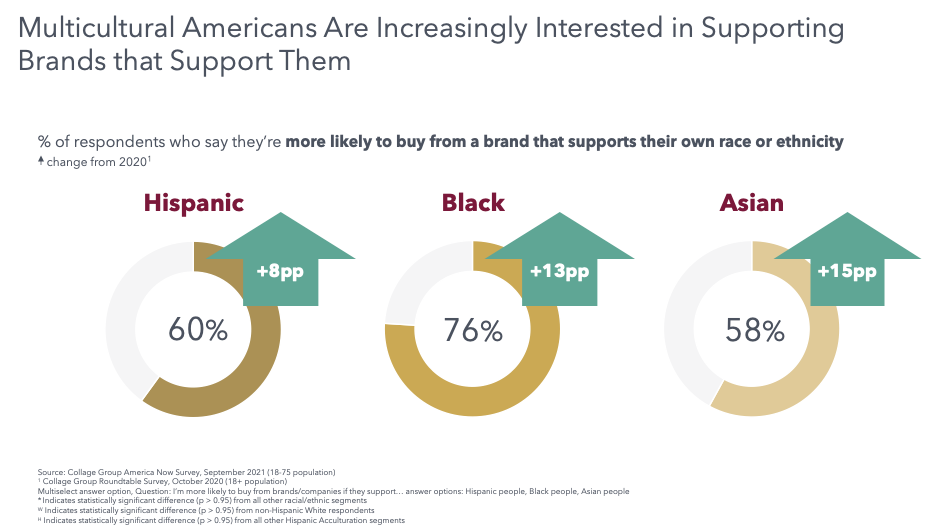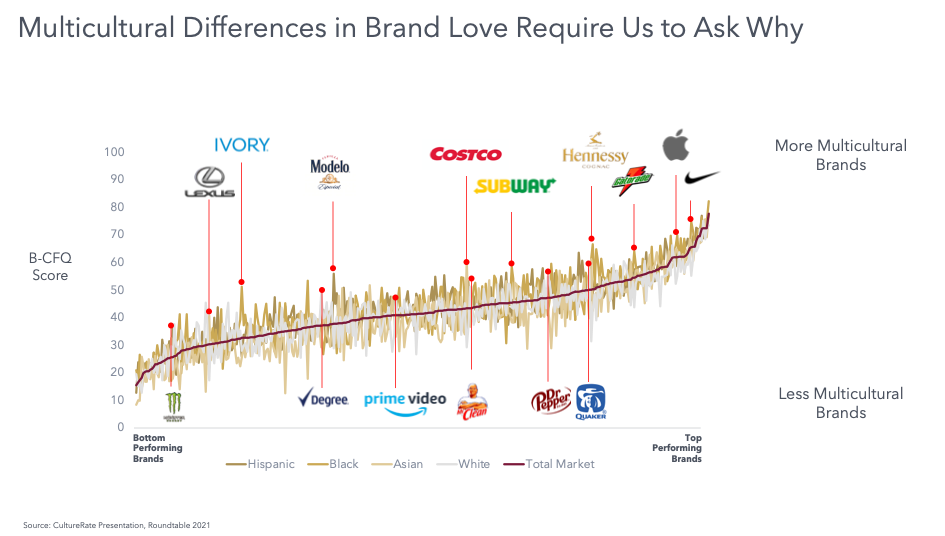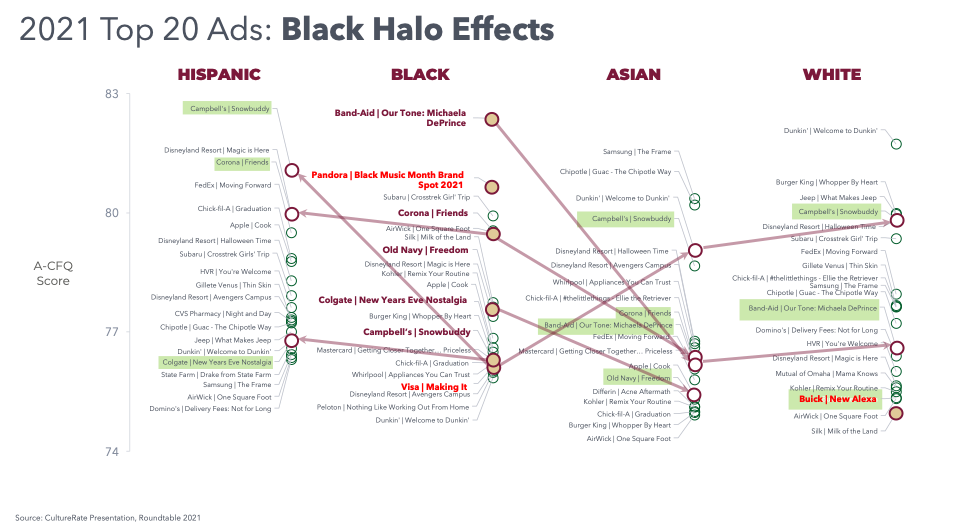CultureRate: Better Target Your Brand While Driving Halo Effects in Ads

Using our CultureRate database, we analyzed over 500 brands and 100 ads gathered across the last 12 months to establish a set of lessons that help marketers better connect with today’s “New Wave” consumers between 18 and 41, across race and ethnicity.
Read on and fill out the form for an excerpt from our CultureRate:Brand – Better Target Your Brand While Driving Halo Effects presentation.
Brands Are Challenged by Rising Cultural Diversity and Polarization
As shown in research accompanying this initiative, marketing and insights leaders face increasing pressure to translate the rapid cultural transformation underway in the U.S. marketplace into clear action steps for brands. From 2020 to 2021, we witnessed an astonishing 10 percentage point-plus increase in the already-high importance of race and ethnicity for multicultural consumers, even as satisfaction of portrayals fell by an average of 8 percentage points.

One thing is for certain: the increase in multicultural consciousness that arose in the wake of COVID-19 lockdowns and George Floyd’s murder has not reverted to norm. Cultural Fluency is emerging as a new mandate for marketing as a whole, and can no longer be understood as a sideshow to the main act of mainstream marketing. Cultural Fluency demands that brands use culture to connect effectively and authentically within and across segments.
How CultureRate:Ad Reveals Powerful New Insights
To address these issues, we launched CultureRate in 2018, a brand and creative evaluation methodology that is now providing our members with powerful new insights into brand and ad performance across cultural groups.
CultureRate is different from any anything on the market today, in four distinct ways:
- Culture is Intrinsic to the Entire Approach: CultureRate positions culture as the primary lens through which to understand diverse segments.
- CultureRate is Grounded in Science of Group Emotion and Rationality: Our approach is based on long-ignored research into the psychology of group emotion and emerging insights from evolutionary psychology into the role of rationality as a mechanism for signaling group affiliation. CultureRate breaks new ground by fully recognizing that consumers not only make decisions to buy products on a path toward optimization of personal net benefits and self-actualization, but also make decisions as a member of group. We have learned nothing since 2016, if not the importance of this phenomenon and the degree to which it completely reframes our understanding of human behavior.
- Rigorously Validated Metrics: We undertook an exhaustive process to identify metrics that matter, identifying the six most critical component metrics for CultureRate:Brand through an exhaustive review of 20 candidate metrics to derive the critical six that optimally reflected cultural dimensions while predicting brand favorability.
- Linkage to Cultural Traits of Consumers: methodology is integrated within Collage Group’s Cultural Traits system, a rigorously proven method for measuring cultural variation, that enables marketing professions to link how using cultural insights into specific segments improve ad and brand effectiveness. Explore how Cultural Trait analysis works when applied to Black consumers.
Unrivaled Rigor and Database Depth
The methodology introduces two important new metrics: the Brand Cultural Fluency Quotient (B-CFQ) and the Ad Cultural Fluency Quotient (A-CFQ), composed of six and four subcomponent metrics respectively, both of which were designed to optimally predict favorability and purchase intent. A-CFQ is also complemented by Backlash, which takes conventional brand favorability a step further by quantifying the degree to which an ad can “flip” perception from positive to negative or vice versa. Combining A-CFQ and Backlash metrics for target segments reveal the dynamics that make ads successful.
Top Lessons for More Inclusive Marketing
- Brands need to appreciate the different reasons multicultural Americans love brands.

- Multicultural consumers are much more likely to appreciate brands when they specifically see that the brand is for “people like me.” Gain an edge: go to extremes to show how your brand is for multicultural Americans.
- Trust is a game changer for Black Americans. Lean into opportunities to show how your brand has supported the segment, how your brand embodies values core to the segment, and/or connects to the Black Group Trait of Perseverance.
- Hispanic Americans’ uniquely express their affiliation for a brand through their willingness to advocate for the brand to others. Leverage Hispanic Group Traits of Warmth and being Tuned-In to prime them to be a trend-setter on your behalf. Give Hispanic consumers a reason to talk about your brand and they will reward you with mentions, word of mouth and other opportunities to drive earned media attention.
Our research into ad performance revealed that:
- Halo effects are much more common than you think, even as targeted ads remain important, especially for Black and Hispanic consumers

- Brands can drive inclusivity by showing how consumers are part of a spectrum of shared experience. Associate Black or Hispanic agency with the Passion Points of other groups.
- Cross-generational familial bonds provide immense power for storytelling: The extended family relationships of younger consumers are your unsung opportunity.
- Black consumers will punish you for poor representational choices, especially on themes that are universal. Ensure any “vignette” approach to a universal experience includes Black people.
- Culturally-specific humor may not halo well. Increase the reliability of halo effects by appealing to universal themes of Connection (family, friends, and community).
- Social justice messages that address multicultural issues work well when the consumers see the direct benefit of an investment in opportunity for real people.
- The preferences of White consumers may be a poor guide for the general market appeal.
Contact us to learn how you can access the deep cultural intelligence that drives growth for Collage members.